Thalamocortical connections of functional zones in posterior parietal cortex and frontal cortex motor regions in New World monkeys
- PMID: 20080929
- PMCID: PMC2936798
- DOI: 10.1093/cercor/bhp308
Thalamocortical connections of functional zones in posterior parietal cortex and frontal cortex motor regions in New World monkeys
Abstract
Posterior parietal cortex (PPC) links primate visual and motor systems and is central to visually guided action. Relating the anatomical connections of PPC to its neurophysiological functions may elucidate the organization of the parietal-frontal network. In owl and squirrel monkeys, long-duration electrical stimulation distinguished several functional zones within the PPC and motor/premotor cortex (M1/PM). Multijoint forelimb movements reminiscent of reach, defense, and grasp behaviors characterized each functional zone. In PPC, functional zones were organized parallel to the lateral sulcus. Thalamocortical connections of PPC and M1/PM zones were investigated with retrograde tracers. After several days of tracer transport, brains were processed, and labeled cells in thalamic nuclei were plotted. All PPC zones received dense inputs from the lateral posterior nucleus and the anterior pulvinar. PPC zones received additional projections from ventral lateral (VL) divisions of motor thalamus, which were also the primary source of input to M1/PM. Projections to PPC from rostral motor thalamus were sparse. Dense projections from ventral posterior (VP) nucleus of somatosensory thalamus distinguished the rostrolateral grasp zone from the other PPC zones. PPC connections with VL and VP provide links to cerebellar nuclei and the somatosensory system, respectively, that may integrate PPC functions with M1/PM.
Figures



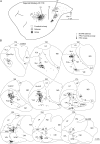


Similar articles
-
Cortical connections of functional zones in posterior parietal cortex and frontal cortex motor regions in new world monkeys.Cereb Cortex. 2011 Sep;21(9):1981-2002. doi: 10.1093/cercor/bhq260. Epub 2011 Jan 24. Cereb Cortex. 2011. PMID: 21263034 Free PMC article.
-
Organization of the posterior parietal cortex in galagos: II. Ipsilateral cortical connections of physiologically identified zones within anterior sensorimotor region.J Comp Neurol. 2009 Dec 20;517(6):783-807. doi: 10.1002/cne.22190. J Comp Neurol. 2009. PMID: 19844952 Free PMC article.
-
Thalamocortical connections of anterior and posterior parietal cortical areas in New World titi monkeys.J Comp Neurol. 2006 Jul 20;497(3):416-35. doi: 10.1002/cne.21005. J Comp Neurol. 2006. PMID: 16736469
-
Evolution of posterior parietal cortex and parietal-frontal networks for specific actions in primates.J Comp Neurol. 2016 Feb 15;524(3):595-608. doi: 10.1002/cne.23838. Epub 2015 Jul 21. J Comp Neurol. 2016. PMID: 26101180 Free PMC article. Review.
-
Specialization of reach function in human posterior parietal cortex.Exp Brain Res. 2012 Aug;221(1):1-18. doi: 10.1007/s00221-012-3158-9. Epub 2012 Jul 10. Exp Brain Res. 2012. PMID: 22777102 Review.
Cited by
-
The marmoset monkey as a model for visual neuroscience.Neurosci Res. 2015 Apr;93:20-46. doi: 10.1016/j.neures.2015.01.008. Epub 2015 Feb 13. Neurosci Res. 2015. PMID: 25683292 Free PMC article. Review.
-
The Multiple Representations of Complex Digit Movements in Primary Motor Cortex Form the Building Blocks for Complex Grip Types in Capuchin Monkeys.J Neurosci. 2019 Aug 21;39(34):6684-6695. doi: 10.1523/JNEUROSCI.0556-19.2019. Epub 2019 Jun 24. J Neurosci. 2019. PMID: 31235643 Free PMC article.
-
Population interactions between parietal and primary motor cortices during reach.J Neurophysiol. 2014 Dec 1;112(11):2959-84. doi: 10.1152/jn.00851.2012. Epub 2014 Sep 10. J Neurophysiol. 2014. PMID: 25210154 Free PMC article.
-
Projections of the superior colliculus to the pulvinar in prosimian galagos (Otolemur garnettii) and VGLUT2 staining of the visual pulvinar.J Comp Neurol. 2013 May 1;521(7):1664-82. doi: 10.1002/cne.23252. J Comp Neurol. 2013. PMID: 23124867 Free PMC article.
-
Different evolutionary origins for the reach and the grasp: an explanation for dual visuomotor channels in primate parietofrontal cortex.Front Neurol. 2013 Dec 23;4:208. doi: 10.3389/fneur.2013.00208. Front Neurol. 2013. PMID: 24391626 Free PMC article. Review.
References
-
- Alder LD. Thalamic connectivity of rat somatic motor cortex. Brain Res Bull. 1988;20:333–348. - PubMed
-
- Alexander GE, DeLong MR, Strick PL. Parallel organization of functionally segregated circuits linking basal ganglia and cortex. Annu Rev Neurosci. 1986;9:357–381. - PubMed
-
- Asanuma H, Rosen I. Topographical organization of cortical efferent zones projecting to distal forelimb muscles in the monkey. Exp Brain Res. 1972;14:243–256. - PubMed
-
- Battaglia-Mayer A, Ferraina S, Mitsuda T, Marconi B, Genovesio A, Onorati P, Lacquaniti F, Caminiti R. Early coding of reaching in the parietooccipital cortex. J Neurophys. 2000;83:2374–2391. - PubMed
-
- Cappe C, Morel A, Rouiller EM. Thalamocortical and the dual pattern of corticothalamic projections of the posterior parietal cortex in macaque monkeys. Neuroscience. 2007;146:1371–1387. - PubMed

